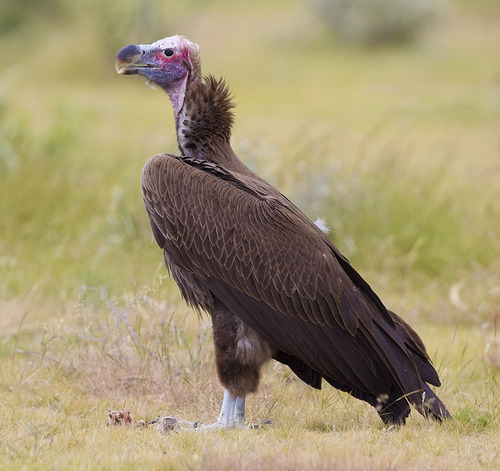
Lappet-faced Vulture
The Lappet-faced Vulture (*Torgos tracheliotos*) is a large Old World vulture found across much of Africa and parts of the Middle East. It is easily recognizable by its bare, pink head and prominent, fleshy folds of skin (lappets) on the sides of its neck. This vulture plays a crucial ecological role as a scavenger, efficiently disposing of carcasses and thereby helping to prevent the spread of disease. It is often the dominant vulture species at a carcass, able to tear through tough hides that other vultures cannot.
95-115 cm
Length
255-290 cm
Wingspan
Endangered
Conservation Status
Distribution
Found across sub-Saharan Africa, with a patchy distribution. Also found in the Arabian Peninsula and parts of the Negev Desert in Israel. Historically, it was more widespread in North Africa and the Middle East.
Lifespan
Up to 50 years in captivity, likely 20-30 years in the wild (though data is limited).
Lappet-faced Vulture's Habitat
Habitat Types
Savannas, Grasslands, Semi-deserts, Open woodlands, Mountain slopes
Climate Zones
Tropical, Subtropical, Arid
Adaptations
Tolerates high temperatures and arid conditions. Its large size and powerful beak allow it to access carcasses even in areas with intense competition from other scavengers.
Variations
Three subspecies are sometimes recognized: *T. t. tracheliotos* (Africa), *T. t. negevensis* (southern Israel), and *T. t. nubicus* (Egypt, Sudan, Arabian Peninsula). These differ slightly in size and coloration, but the distinctions are not always clear.
Appearance
Breeding Plumage
No significant difference between breeding and non-breeding plumage.
Seasonal Feather Changes
No significant seasonal variations.
Sex Based Plumage Differences
Minimal sexual dimorphism, although females tend to be slightly larger and may have slightly darker plumage.
Notable Features
Bare, pink head and neck with prominent lappets., Powerful, hooked beak., Dark brown to black body plumage., White downy feathers on the thighs.
Diet and Feeding
Primary Foods
Carrion (dead animals), Small live prey (occasionally)
Foraging Behavior
Soars at high altitudes to locate carcasses, often following other vultures or scavenging mammals. It is a dominant species at carcasses, using its size and powerful beak to displace other scavengers.
Specializations
Its strong beak allows it to tear through tough hides and access parts of the carcass that other vultures cannot reach. It can consume large amounts of food quickly.
Seasonal Diet Variations
Diet may vary slightly depending on the availability of carcasses, which can be influenced by factors like migration patterns of ungulates and seasonal rainfall.
Behavior
Social Structure
Generally solitary or found in pairs, but can congregate in large numbers at carcasses.
Communication
Hissing and grunting sounds at carcasses., Visual displays (e.g., spreading wings, raising lappets).
Migration
Mostly resident, but some populations may undertake local movements in response to food availability or rainfall.
Territorial or Group Behaviors
Defends its nest site and the immediate area around a carcass. Dominance hierarchies are established at feeding sites.
Conservation
Threats
Poisoning (both intentional and unintentional), Habitat loss and degradation, Collisions with power lines, Electrocution, Decline in wild ungulate populations (reduced food availability), Human disturbance
Protection Programs
Anti-poisoning campaigns, Habitat restoration and protection, Monitoring of populations, Captive breeding programs (limited success)
Local National Laws
Protected under various national and international laws, including CITES Appendix II.
Population Trend
Decreasing
Population Estimates
Estimated at fewer than 8,000 mature individuals, and declining.
Interesting Facts
They are among the most powerful vultures in Africa.
Their strong beaks allow them to tear open carcasses that other vultures cannot.
The bare skin on their head and neck is thought to help with thermoregulation.
It allows them to dissipate heat in hot environments.
They can consume bone fragments.
This provides them with a source of calcium.
Their scientific name, *Torgos tracheliotos*, is derived from Greek and refers to the 'windpipe' or 'trachea',
possibly a reference to the wrinkled appearance of the neck.
Faqs about Lappet-faced Vulture
Why are Lappet-faced Vultures endangered?
The primary threat is poisoning, often from carcasses laced with poison intended for predators like lions or hyenas. Habitat loss and collisions with infrastructure also contribute to their decline.
What is the purpose of the lappets on their neck?
The exact function is not fully understood, but they may play a role in display, communication, or thermoregulation.
Do Lappet-faced Vultures kill livestock?
They are primarily scavengers and rarely kill live prey. Any reports of them killing livestock are likely to be cases of mistaken identity or scavenging on already dead animals.
How can I help Lappet-faced Vultures?
Supporting conservation organizations working to protect vultures and their habitats is a great way to help. Raising awareness about the importance of vultures and the threats they face is also crucial.
Copyright @ Nature Style Limited. All Rights Reserved.
 English
English